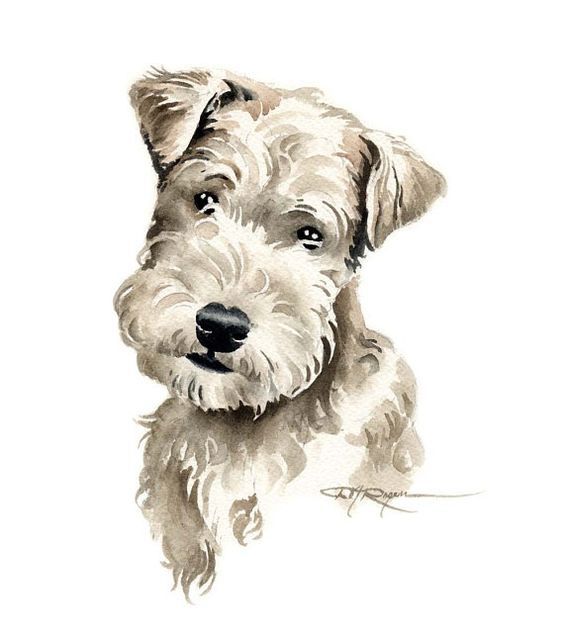
There are some topics that are so big, we wonder why anyone would to attempt to tackle them in a short post. We’re going to give it a shot, anyway. We’re talking about grooming a terrier, and specifically, grooming a Lakeland Terrier. As we see it, a tiny hint of of the topic is better than nothing, if only to give tribute to the terrier people who groom their dogs with dedication.
Grooming any dog properly for its breed is an art, and though we write this next part with our tongue a bit in cheek, a stripped Lakeland Terrier almost looks like a different breed from one that is ungroomed. The Lakeland Terrier has a double coat that is comprised of a protective wiry outer-coat, and a soft under-coat that gives the dog warmth. Though this breed will shed hair naturally, and the coat can be mechanically clippered, hand-stripping a Lakie not only controls shedding, it promotes new hair growth of the proper texture and color. An untouched Lakeland lacks the elegant silhouette one sees in a show ring, and while clippering can restore the “shape” of the dog’s outline, it impacts coat texture and color (since only the upper portion of a terrier’s top coat is actually colored).
We digress for a moment to mention that generally speaking, breeds with a wiry or “rough-coat” benefit from hand stripping. When the hairs of the top coat get as long as they’re going to get, they start dying and remain loosely attached to the hair follicle until they shed naturally, or are removed. Hand stripping a coat simply means removing the outer guard hairs once a dog’s coat is “blown.”
Many people rely entirely on their fingers to grasp these hairs and “pluck” them out, a method that purists and “old school” groomer insist is the proper way to do the job. Others may use a blunt stripping knife, sometimes with chalk or rosin to offer a better grip on the tool as leverage against the thumb to pull the hair at an angle. They may also wait to perform the task on a dirty coat because it’s easier to grip hair. Either is a method that aforementioned purists feel damages coat by breaking hair. Either way, a groomer gets into a rhythm of pulling coat in the direction in which the coat grows. If a dog is routinely hand-stripped, eventually the dog’s coat can be ‘‘rolled” so that only the longest top hair is pulled out while the new coat is growing in underneath. Keeping hair at different lengths ensures that there should always be enough new coat coming in to keep the terrier’s outline neat. Some may regard this akin to “staging,” or preparing a dog for a particular date, like a dog show. Different parts of the dog are stripped according to a schedule to ensure that each area grows at a different rate to show off the dog’s structure or best attributes.
This would be a good place to mention that while hand stripping promotes a wonderfully wiry coat by removing dull and lustrous hair, and by encouraging growth of new, brightly colored, using mechanical clippers to groom this kind of coat dog removes the hard end of a wiry hair, and the faded part grows further out. Put another way, clipping a coat simply takes off the top layer of dead hair, and the coat is typically duller in texture and color.
Aesthetics is not the only reason to strip a coat. In some breeds, topcoat doesn’t shed naturally, and new guard hairs don’t have room to grow. This can cause a dog to get itchy and rub against walls, furniture or the carpet to relieve the itch (and thereby remove dead coat causing the itchiness in the first place). Handstripping leads to healthier skin. Furthermore, hand stripping promotes a wire coat that serves as protection when the terriers are doing their jobs, such as going to ground, barn hunting, or going after foxes, etc. This type of coat is a protective shell that repels water, stickers, and debris that the dogs would otherwise collect. Hand stripping doesn’t stop everything 100% , but it prevents a lot.
To conclude this section, it’s not only terriers can be handstripped. Breeds that gain from handstripping include Affenpinschers, German Wirehaired Pointers, Irish Wolfhounds, Schnauzers, Bouvier, Wirehaired Pointing Griffons, Wirehaired Dachshunds, and of course, many from the terrier group including the breed we return to discussing, the Lakeland Terrier.
At this point, we want to thank the owners of Lakies who not only coached us on grooming their breed, but have generously allowed us to share their pictures in this “show and tell” portion of the post.
Meet “Cookie, the dog below. Also known as GCH Delzar Cookie Cutter, her mistress, Patty, jokingly says that Cookie has “let herself go” with her third litter: Hair not combed, teeth not brushed, breakfast dishes un-rinsed and still sitting on the table….
As an aside, Patty adds that grizzle and tan, and black and tan Lakies all look like “Rottweiler burritos” when they’re born. The two puppies in this photo were eventually grizzle and tan with just a small dark-colored saddle, just like their mom.
And just to show how beautifully Cookie “cleans up” with a proper grooming, this is her below. Like wow, right?
Earlier, we touched upon color, and the impact that clipping versus hand stripping has on a color. In the photo below, the red male Lakeland Terrier appears to be more wheaten colored due to loss of color once he was clippered. Lakeland hairs are designed to be hand-stripped, and as each hair ages, it gets thinner, softer, and loses whatever color it had. By the time it’s two to three inches long and ready to fall out on its own, it’s almost pure white.
Henry’s coat is hard. Because of its fuzziness, one might think it’s soft, but one touch reveals that it’s a hard coat like one would expect to feel on a stripped dog.
We don’t have permission to share this picture, but it’s a good example of a coat change as it gets long or “blown.” Take a look at it. The hair nearest the thumb is the oldest hair, and wiry. As it grows out, it becomes softer and lighter in color as can seen.
We have some pictures from Eva Fekete of Australia to illustrate an ungroomed Lakie:
This is quite a contrast to a handstripped Lakeland like the one you see below:
There is something called “pet stripping” which allows a non-show terrier to maintain a proper coat texture and color, and while it’s not show grooming, it simply incorporates some of the techniques touched upon above to keep the dog in a proper coat.

Hand stripping takes time, and no one is to be blamed for clippering a dog when at the end of the day, it’s more important that a dog be lovingly groomed than how. That said, a hand stripped coat is a thing of beauty and if you’re ever at a dog show, stop by the terrier ring when Best of Breed is being determined for Airedales, Cairn Terriers, Wire Fox Terriers, Jack Russells, Scotties, Lakeland Terriers, or Dandie Dinmonts.
Our special thanks to Vicki, Patty, Tena, Michelle, Beth, Eva, and Kittie for their help and/or photographs.
Image: Lakeland Terrier puppy by DJ Rogers – k9artgallery
http://dogprintsgallery.com
www.etsy.com/shop/k9artgallery

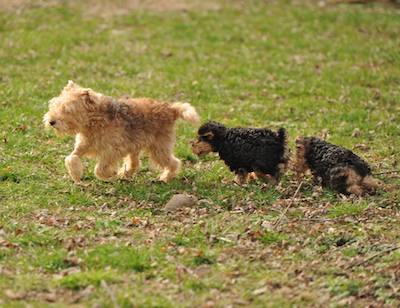
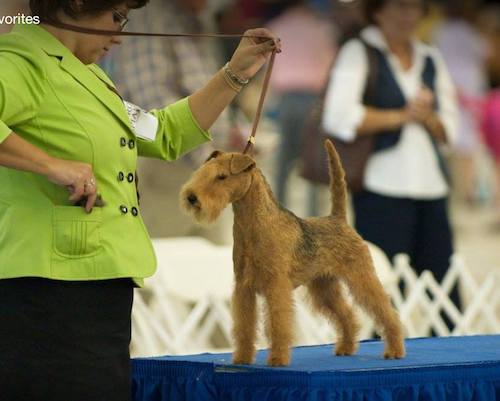

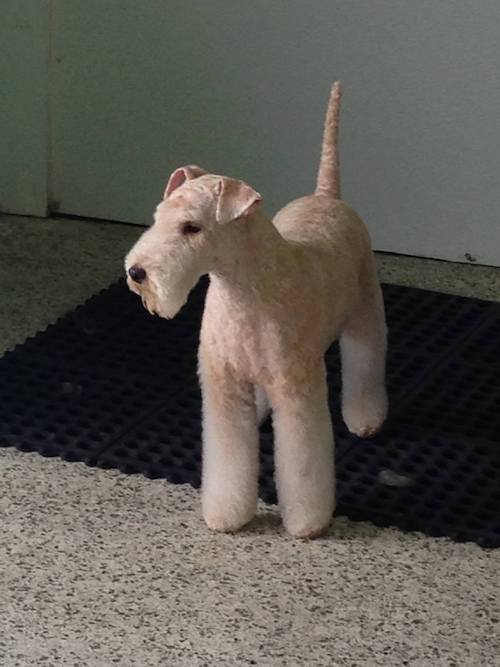
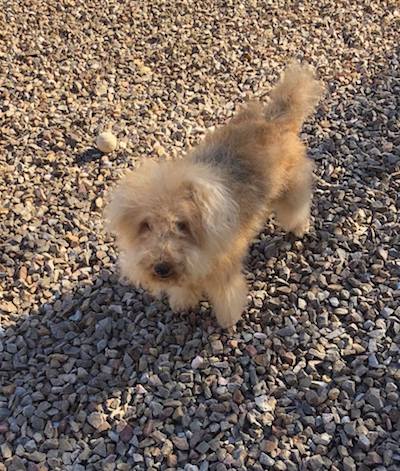
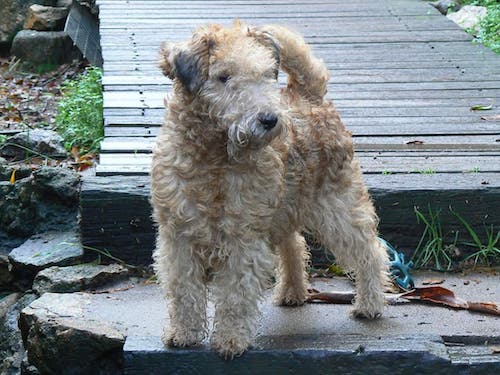 …
… …
…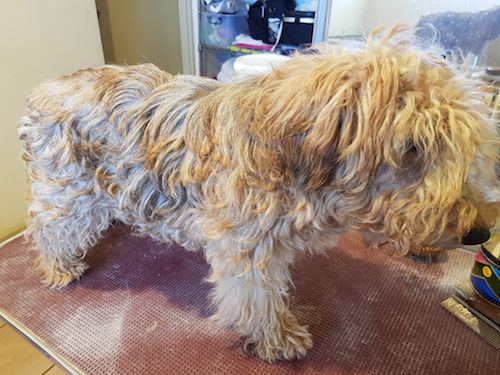
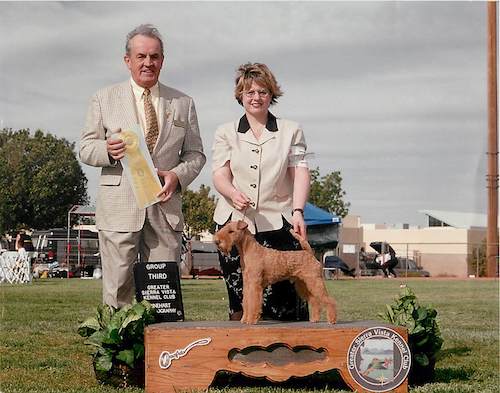
A small factual correction: Patty is not the mistress of Cookie. Cookie is more like the mistress of Patty.
Hahaha, Patty, correction noted!
Fantastic article! So nice to see the positives emphasized so thoroughly. Well done!
Gosh, Tena, thanks! As corded dog owners, hand stripping is a bit foreign to us, so your kind comment is most welcomed!
Hello and thank you for such an informative article. I have a rescue Scottie mix (male, wheaton colour) and I don’t know if he’s been clipped, but his coat is hard and yellowish. I have brushed him repeatedly and used a “rake” to shorten the hair a little. It is about 3″ long.
I would like to handstrip him, but I’m worried that since he’s not a pure Scottie the other breed in the mix might not be handstripped. When I’ve tried to pull out hair, as I’ve seen done in many videos by professionals, I get very little tufts barely worth the trouble.
Please advise as I cannot decide whether to buy gloves and chalk and keep trying to pull the hair out or simply accept his blown coat look and brush and rake from here on in.
Best Regards,
Babx